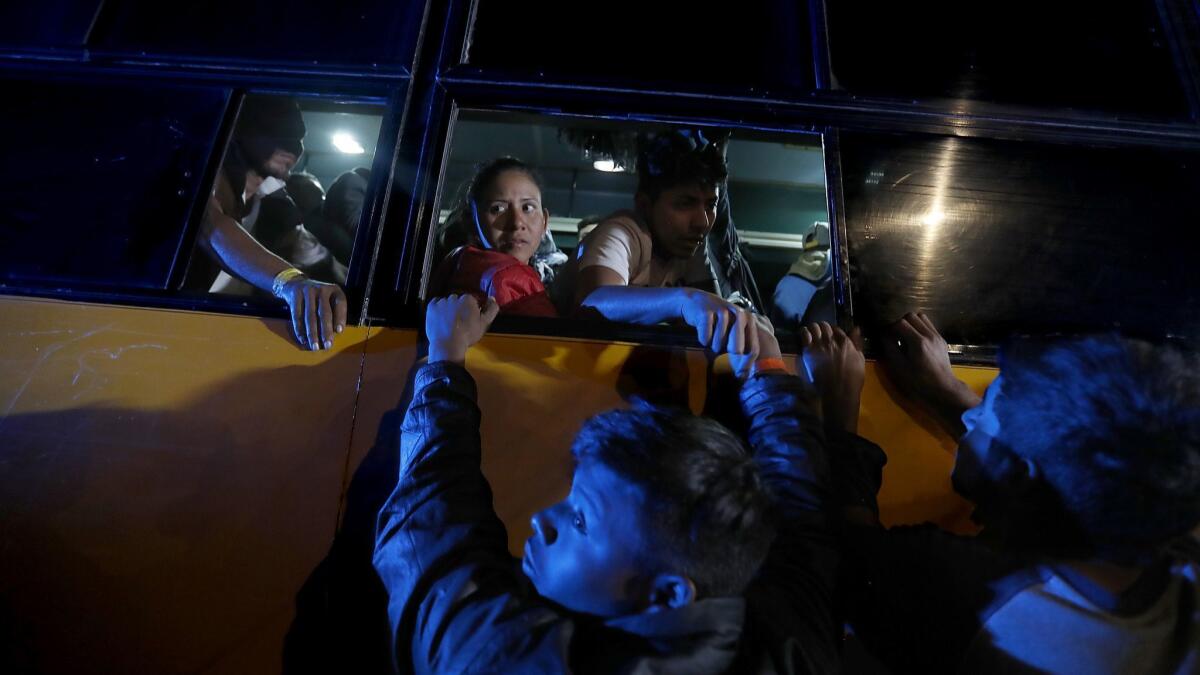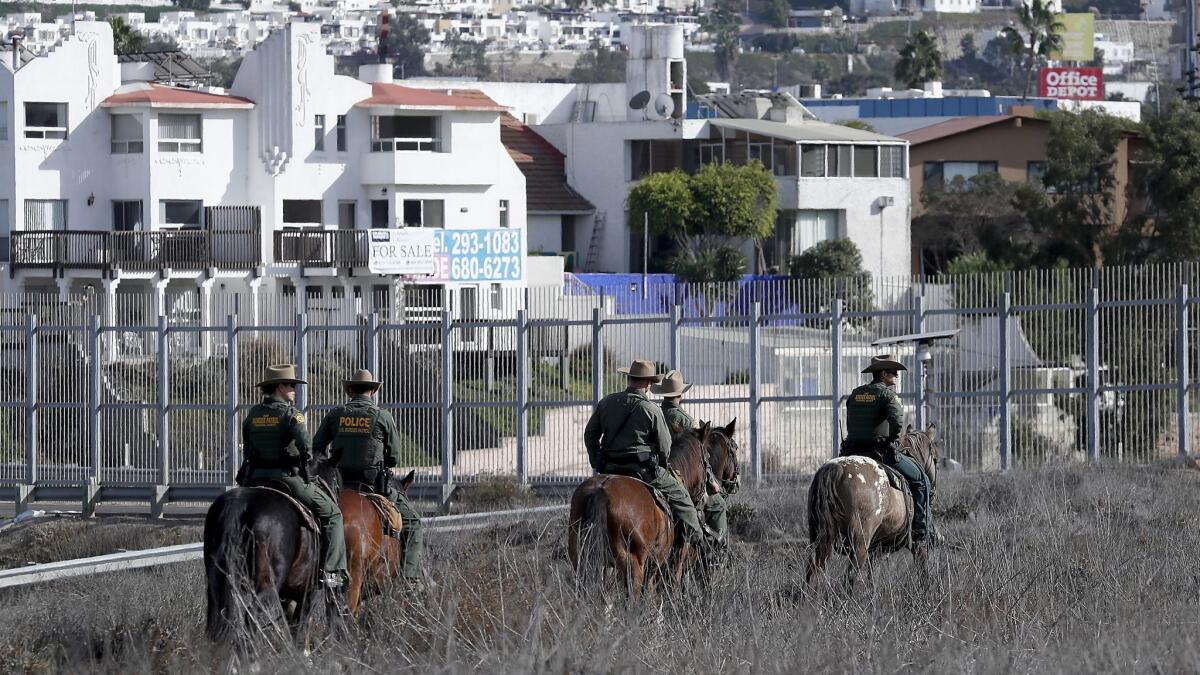Caravan attracts diplomats and denouncers in Tijuana

- Share via
Reporting from Tijuana — The Honduran diplomat said he came to express solidarity with his many compatriots who have descended on this border town in recent days as part of the Central American migrant caravan.
“These are our people, we want to do what we can for them,” Alden Rivera, the Honduran ambassador to Mexico, told reporters Saturday during a morning visit to a sports facility here that is currently home to more than 2,600 migrants, mostly Hondurans. “In Honduras we respect human rights.”
His presence drew angry reactions from a number of camp residents, who labeled the current, U.S.-backed government in Tegucigalpa a corrupt regime that maintains autocratic rule over a largely impoverished society.
“If we had work and a proper government in Honduras we wouldn’t have had to embark on this difficult trip and live outdoors,” complained Maria Ramirez, 33, who said she was an outdoor fish vendor back in her hometown of San Pedro Sula, where the caravan started more than a month ago. “How dare he come here and say he wants to help us!”
The ambassador’s entourage kept the diplomat shielded from the angry migrants, many of whom are expected to seek political asylum in the United States, asserting that they face persecution in their homeland.
“This ambassador and all the other politicos from Honduras should be in jail!” declared Hugo Lara, 28, from the Honduran town of Copan. “They stole all the money!”
The interaction between the ambassador and the migrants soon ended as the diplomat continued his rounds and the migrants wandered off. It marked just another small ironic wrinkle in the ongoing saga of the caravan.
As more caravan members straggled into Tijuana on Saturday, where they have received a mixed reaction, most joined the more than 2,600 housed at the Benito Juarez sports facility, about a block from the U.S.-Mexico border.
The tall fence, across a busy highway, separates Tijuana from San Diego, but migrants can only see the sky above California. The fence blocks views of the land across the border line.
The Honduran ambassador, as well as a number of Mexican officials, visited the camp on Saturday as an expanding number of international media crews also arrived in Tijuana, keen to tell the story of the migrant caravan, which traveled about 3,000 miles to get here. Journalists lined up for limited access hours in the morning and afternoon, even as President Trump, who focused an unrelenting publicity blitz on the caravan prior to the recent U.S. election, has since stopped talking about it.

“What tribe are you from?” one TV journalist asked Jose Vargas, 36, a construction worker from the Honduran city of La Ceiba who, along with friends, used branches to construct a kind of hut near the entrance of the camp.
The unusual construction attracted a lot of press attention. An Italian crew interviewed Vargas about life back home.
“I live in a regular house in Honduras,” a bemused Vargas explained afterward, speaking as he crouched at the entrance of his handcrafted hut. “But the branches here help keep the place cool in the day and warm in the evening.”
The migrants mostly slept in tents pitched on patches of grass and in a soccer field. Many were housed on mats in a gymnasium.
Men were able to bathe Saturday in newly installed outdoor showers on the edge of the soccer field. A truck parked on the street outside provided shower facilities for women.
After a meager breakfast of lentils, tortillas and coffee, many migrants wandered about as aid groups handed out clothing and evangelical pastors headed prayer sessions. One church group organized an exercise session for kids on the soccer field.
Officials in this city of 1.6 million are wondering where to house the expanding ranks of migrants, whose numbers are expected to grow to as many as 10,000 in coming days.
The Tijuana mayor, Juan Manuel Gastelum, has labeled many of the migrants criminals and “bums” and said he was contemplating calling for a referendum on whether the city should accept them. On Sunday, some residents opposed to the migrants’ presence are planning a protest march. There is also talk of a pro-migrant counter-demonstration.
Several migrants sleeping in the gymnasium said they heard rocks landing on the roof of the facility overnight, which they viewed as a hostile act.
But not everyone is hostile to the new arrivals in this border town that has long hosted northbound migrants — and where most residents trace their origins to other parts of Mexico. Residents of Tijuana regularly drove up to the sports facility, donating food and clothing for the migrants.

Tijuana residents protest over Central American migrants caravan.
Caravan participants are keenly uncertain of their fate. The imposing fencing and Border Patrol presence along the international boundary have caused a realization that crossing into the United States will be far from easy. Many are talking about trying to acquire visas for Canada or somewhere in Europe, though such ambitions seem fanciful at the moment.
Meanwhile, on the U.S. side of the border fence, the scene seemed normal on Saturday, though helicopters occasionally buzzed the skies above the border community of San Ysidro. About 2 p.m., a U.S. Marine helicopter landed in the hills behind the Jack in the Box on San Ysidro’s main drag, startling some residents. But the aircraft took off a few minutes later. No one seemed to know why it had come.
In advance of the caravan’s arrival at the border zone, U.S. authorities installed new coils of razor wire on border fences, along the vehicular entry to the United States and even on the beach strip of Border Field State Park, which is adjacent to Tijuana’s beachside Playas de Tijuana neighborhood. Late Friday, the Border Patrol was present in force, with horses, all-terrain vehicles and vans on the U.S. side of the beach.
As the sun set on Saturday, however, a lone Border Patrol agent stood a few feet north of the fence, as people on the Tijuana side peered through gaps in the metal barrier. Sundry visitors made their way to both sides of the fence to have a look, in many cases their curiosity piqued by news of the caravan.
“It’s calm here, but a place with a lot of energy,” said Roberto Provencio, 38, an engineer from San Diego who visited the U.S. stretch of the beach on Saturday. “I came to think, to contemplate, and to say a prayer for the people — for the people on both sides of the fence.”
Special correspondents Cecilia Sanchez in Mexico City and Liliana Nieto del Rio in Tijuana, as well as Times staff photographer Luis Sinco in San Diego, contributed to this report.

Twitter: @PmcdonnellLAT
More to Read
Sign up for Essential California
The most important California stories and recommendations in your inbox every morning.
You may occasionally receive promotional content from the Los Angeles Times.










